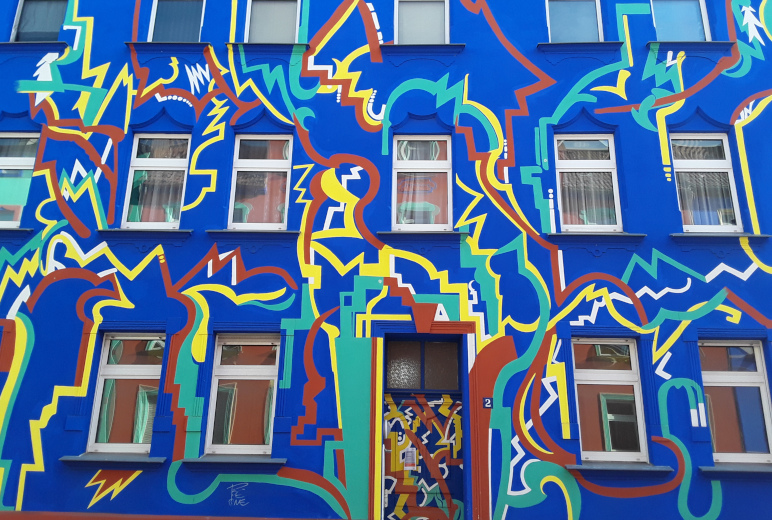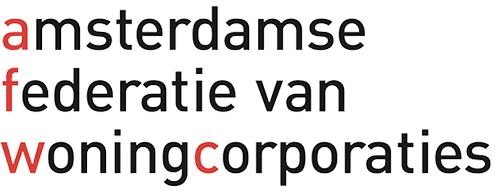Article in NRC-Handelsblad, Friday March 15th 2020
By Bernhard Hulsman (translation: Melle van Maanen for Museum Het Schip)
Exposition
For the German architect Bruno Taut, disparate colours were an indispensable aspect of architecture. More than that, he believed that they could make life more beautiful and improve the quality life itself. As such is shown by Museum Het Schip.
When Le Corbusier, one of most important architects of the twentieth century, saw one of Bruno Taut’s (1880-1938) houses in Stuttgard nearly a century ago, he cried out: “Dear God, Bruno Taut is colour-blind!” If the architect was indeed colour-blind, this can now be determined in the exposition Bruno Taut. Beyond Fantasy in Museum Het Schip in Amsterdam. All the walls in the exposition have been covered in Taut-colours, like Prussian blue, ‘ox-blood-red,’ and orange.
In this way, visitors can also experience how it must have been to live in an apartment in places such as Bitz, Uncle Tom’s Hütte, or other, by Bruno Taut designed, working class neighbourhoods from the 1920s in Berlin. Taut did not only cover the facades, doors and window frames of his worker’s palaces with colours like olive green, purple and brown, but he also treated everything else of the interiors, up until the colours of the stair railings.
Blissful performance of colours
For Taut, colour was not merely a random and interchangeable aspect of architecture, but rather a fundamental ‘element of construction.’ As an expressive architect, Taut believed in the blissful working of colour on the spirits of the residents. He also hoped, for example, that the muffled red floors would prevent residents to put down dusty, unhygienic carpets in their houses.
How he arrived at this conviction, is shown in the first room that is painted in various types of blue, which is mainly dedicated to Taut’s utopic projects that he made in the first years after the First World War. It was not in the bitter stone desert that Berlin presented, with its rental barracks, but rather on the country side and in the mountains that people should live - as such thought Taut and other expressionist architects. Here, new garden cities had to be erected, with Stadtkronen (‘city crowns’) made of tainted glass, that would peek high above the houses like gothic cathedrals. “Exuberant glass destroys the hate”, believed these German architects.
In his book Alpine Architektur from 1919,Taut displayed ‘city crowns’ in the mountains: pagoda-like structures with domes of tainted glass. ‘Mad’, one critic described Taut’s Alpine Architektur. Maybe, Taut replied, but “at least less mad than a system of trenches that reach from the North Sea to the Rhine, and from the Eastern Sea to the Black Sea, where for four years people kill each other by the thousands.”
Rainbow Neighbourhood
Except for his famous Glashaus, a temporary pavilion in Cologne from 1914 which is on show as a huge model in the blue room of Museum Het Schip, Taut’s ‘alpine architecture’ remained a dream. As city architect, however, he managed to transform Magdenburg in a ‘colourful city’ at the start of the 1920s, by painting the city’s new as well as old buildings, including the city council, in bright colours, or by applying whimsical, expressionist compositions. When he was asked later by the housing associations of Berlin to design around ten thousand social housing apartments, he remained loyal to his conviction that colour was an indispensable aspect of the art of building.
After the putsch of the Nazi’s in 1933, it was finished with the construction of colourful working class neighbourhoods, Taut, who had had worked in the Soviet Union in 1932-33, fled to Japan when the Reichstag in Berlin went up in flames. In Japan, Taut had only few opportunities to build, but in Turkey, where he moved in 1936, he realised several buildings, most notably the University building of Ankara.
Although Bruno Taut was published in Wendingen, the magazine and voice of the Amsterdam-School, and had good connections with well-known Dutch architects as H. Th. Wijdeveld and J.J.P. Oud, his influence in the Netherlands was minor – as is shown by Bruno Taut. Beyond Fantasy. Yet, almost sixty years after his death in 1938, the municipality of Almere decided to carry out the Regenboogbuurt (‘Rainbow Neighbourhood’), a new residential neighbourhood of two thousand apartments, in Taut-colours. Architects like Sjoerd Soeters, Jeroen Geurst, and Aldo van Eyck designed this neighbourhood in the spirit of Bruno Taut in 1995, which is on display in the third and last room of this beautifully and carefully composed and designed exhibition.
Bruno Taut. Beyond Fantasy, until October 18th, Museum Het Schip, Oostzaanstraat 45, Amsterdam. www.hetschip.nl



